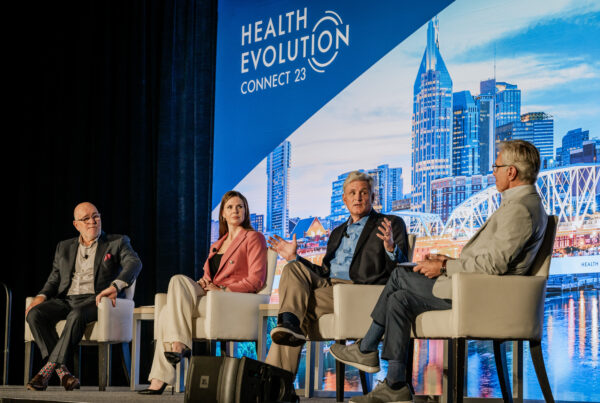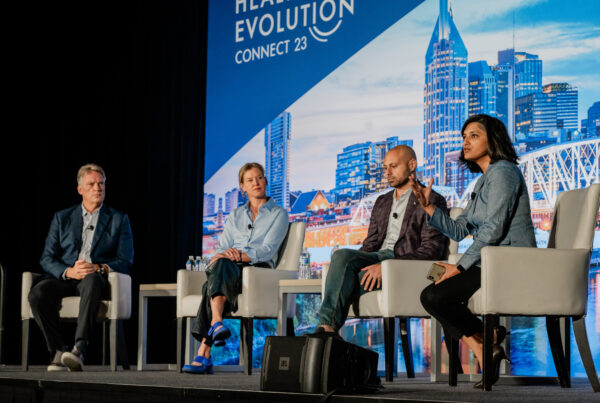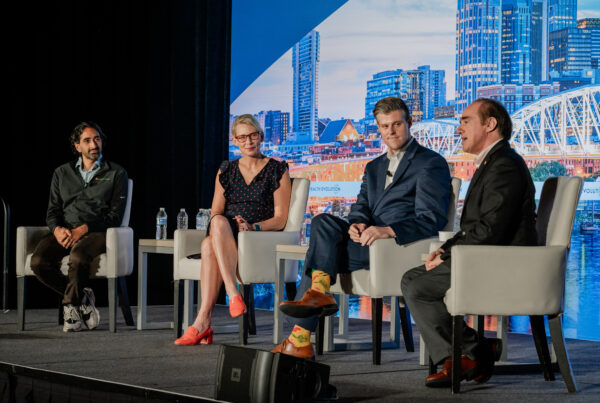In this series, Health Evolution is examining the year 2021 in health care through the lens of our eight imperatives. We will be examining the trends that were at the top of CEOs’ minds throughout the past year and what may come in 2022. First up: Health System Resilience.
Health systems and organizations are dealing with one of the tightest labor crunches in quite some time.
Consider the stats:
-One in five health care workers have quit their jobs since February 2020, according to Morning Consult.
-Of those who have stayed, 30 percent are considering leaving.
-Nearly 80 percent of health care professionals said the national worker shortage has affected them and their place of work.
-Health care employment is down half a million workers, according to Altarium’s analysis.
-There will be a shortage of 1.1 million nurses by next year, according to the American Nurses Association.
-In an effort to keep workers, hospitals and health systems across the country are paying $24 billion more per year for qualified clinical labor than they did pre-pandemic, according to Premier. Overtime hours are up 52 percent and use of agency labor is up 132 percent.
The numbers go on and on. There are shortages among nurses, doctors, home health workers and other critical roles. It’s impossible to ignore the impact of “the great resignation” on health care organizations. Few CEOs in health care are likely to say the labor crunch isn’t among their greatest challenges heading into 2022.
“Workforce is the top challenge right now for CEOs. I don’t know I could start anywhere else at this moment in time than with workforce. All industries are challenged right now, and labor is scarce across the board but in health care, it’s a matter of life and death,” says Brian Tabor, President of the Indiana Hospital Association. “Unfortunately, some of the areas that are most strained are emergency rooms, critical care units and areas that saw the most intense utilization and grimmest stories during COVID.”
Vineet Arora, MD, Dean for Medical Education at University of Chicago Medicine, says that burnout was already a problem pre-pandemic, and it has just been exacerbated over the past two years. “Hospitals are seeing problems with retention. They are offering flexibility, fluidity and top-dollar to keep clinicians, but people have PTSD from the pandemic and there’s an overwhelming sense of ‘I don’t want to do this anymore,’” says Arora. In particular, burnout is impacting clinicians on the frontline, she says.
The problem may be even more dire among rural health care organizations, which have historically had trouble luring in clinicians. The Health Resources and Services Administration (HRSA) released a report this year that found rural regions make up 60 percent of the health care workforce shortage areas in the country. “Rural health care is the study of workforce shortages. We’ve been always dealing with this in rural hospitals and clinics. The pandemic has just accelerated that problem for multiple reasons,” says Alan Morgan, CEO of the National Rural Health Association.
Solutions to the problem
The problem has brought out a number of temporary solutions at health care organizations across the country. Most prominently, hospitals are using agency and temporary labor to fill needs among nurses and other clinicians. As noted above, the costs for these solutions are high and unsustainable. In other places, the Federal Emergency Management Agency (FEMA) has deployed military medical personnel to health care organizations to help them with these staffing challenges. Again, this is not a sustainable method of improving the staffing shortage.
Experts spoke with Health Evolution to share longer-term, more cost-effective strategies.
Identify the specific challenges and communicate. The expense of employee turnover cannot be overstated enough. Between signing bonuses and other perks to get someone on board, the cost to replace one single physician can be in the hundreds of thousands. Too often, health care organizations focus on recruitment, rather than retention, says Arora. They are so busy bringing people into their organization, they aren’t thinking about the people who are already there. She says it’s important for CEOs and other C-Suite leaders within health care to get to the bottom of their current employees’ biggest pain points. This means talking with these people and working with them on their biggest challenges. It can’t be inauthentic, Arora says, otherwise employees will see through it. According to an analysis from McKinsey, more appropriate recognition and open lines of communication are the two most effective strategies in supporting and retaining nurses.
Have a deliberate strategy. Health care is one of the few sectors where work-from-home is not an option for many employees. However, this doesn’t mean that health care executives should not heed the advice of Robert Fenton, CEO of Qualio, a life sciences company that has quadrupled its workforce from 60 to 250 employees during the pandemic, while retaining much of its staff. “We were a remote company before the pandemic and we will be remote after the pandemic, so we don’t have mixed messaging. A lot of companies have that problem where they don’t know what they are and that’s a major thing to not have conviction on if you’re trying to recruit and retain people. We were very deliberate,” Fenton says. “Every company has been and always will be a people business. People forget that and don’t often put the people side of the business on the level of priority that it deserves.” Whether it’s remote work, policies around flexibility and scheduling, or something else, health care organizations should have a deliberate and consistent strategy that caters to its people.
Offer better benefits. Arora can’t help but roll her eyes when health care organizations offer pizza and other “benefits” to burned out clinicians. “The idea that you’re going to cure burnout with pizza is laughable,” she says. While money does help, Arora says that no amount of money will get people to stay in a terrible job. Instead, organizations should focus on professional growth. If there are initiatives that promise employees a path towards career advancement and education, they might be willing to stay with the organization.
This is certainly the case for direct care workers, says Helen Adeosun, Founder and CEO of CareAcademy, which provides a platform for direct caregivers in home health settings. She says that 94 percent of the caregivers the company surveyed said access to further education was an important consideration in accepting a job offer. Approximately 75 percent of these workers have not talked about this interest with their employer. The growing importance of this workforce, Adeosun says, makes it an important area for workforce development and recruiting.
“In the midst of COVID…so much of where health care is happening has shifted to the home and community. That’s where people feel more empowered to receive health care…and it’s where people feel safest,” Adeosun says. “Given that we know that health care in the home and communities will be provided by direct care workers, we have to focus rapidly on developing this workforce. We have to focus on upskilling this direct care workforce, so we have more people who are better enabled to manage the care of individuals.”
Another benefit that goes beyond money and pizza is flexibility. Ryan Nagy, President of IU Health, says that the organization has taken this kind of approach to heart. “We used to have a 50-page document that described your appearance and how you show up to work. That’s five pages now. It’s more about intent and value rather than some top-down, rules-based approach,” he says.
Technology. A McKinsey report estimates that one-quarter of all jobs will be replaced by automation in 2030. While these predictions can incite fear from workers, particularly clinicians, there is a lot of opportunity to use automation and technology to address the worker shortage in health care. One report from Stanford Medical found that physicians, residents, and students expect that almost a third of their duties could be automated by technology in the next 20 years.
Stephanie Lahr, MD, CIO & CMIO, Monument Health, said in a recent Health Evolution webcast, A Bold Future for AI & Patient Centered Care, that her organization is looking for opportunities to use automation to solve the worker shortage crisis. “It’s not just our clinical staff, it’s our patient appointments center staff. We have had a difficult time finding front desk people. There are ways to take some of the work that they’re doing and automate it with AI and other tools that allow them to be able to work at the highest level of their education. That then allows that clinic to work more effectively, and if necessary, with a lower number of people,” Lahr says. “Not because we don’t want to hire them but because we honestly can’t find them.”
Federal government to the rescue? If all else fails, ask the government to help. And for many health care organizations, they might just need to advocate for the “Build Back Better” bill that was passed by the House and is being considered by the Senate. This is particularly true in the home health care space, which has welcomed the bill with open arms.
Build Back Better includes $1 billion for direct care workforce competitive grants and $20 million for hospice and palliative nursing programs. “We’re seeing across the board, federally and on the state side, the opportunity to really build up the direct care workforce. There’s a level of specificity in that legislation that’s never been there before because I think we realize now that this is not about just the workforce shortage. It is now a public health crisis,” Adeosun says.
Build Back Better would also allocate $2 billion to National Health Service Corps, which provides scholarships and loan repayment to qualified health care providers in exchange for service in underserved parts of the country. There is also money earmarked for nursing job development both in underserved areas and more generally. Whether it’s through Build Back Better or another piece of legislation, Morgan at the National Rural Health Association says that there needs to be more federal funds dedicated to developing workforce in these underserved areas.
“A longer-term solution to this problem is looking at the tools of the HRSA and the National Health Service Corps. They are looking at programs where they forgive student loans for agreeing to serve in rural communities. There has to be more money put into rural residency programs, dedicated teaching programs that identify rural kids and train them in rural settings,” Morgan says. “As a result of the pandemic, we’re going to have to rebuild the rural health workforce.”










